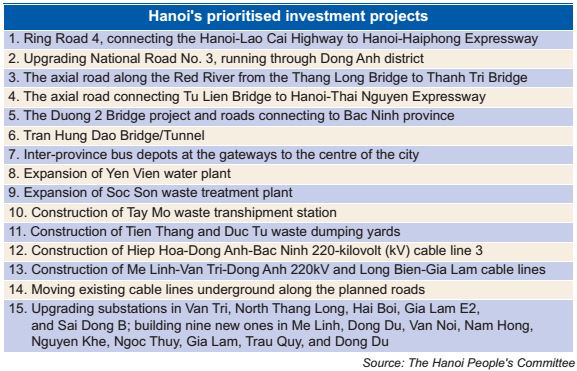Hanoi will focus its foreign investment attraction on transport, logistics, healthcare, education, and waste treatment in a move to become a smart city in the future.
Nguyen Doan Toan, Vice Chairman of the Hanoi People’s Committee, said at last week’s seminar “Hanoi meets the British Business Group Vietnam (BBGV) – Strengthening the Economic Partnership” that the city has basically finished its urban zoning plans for the northern part of the Red River.
“The city will develop high-tech, new technology, clean energy, and international-standard services under the foreign-invested and public-private partnership format, to develop Hanoi into a smart city. We will target foreign investments in metro lines, beltways, car parks, entertainment areas, industrial park infrastructure, logistics, healthcare, education, waste treatment, and high-tech agriculture,” Toan said
For this new orientation, Hanoi has built zoning plans for economic sectors including transport, water supply, electricity, education, and healthcare, to enable the city to attract foreign investment more effectively.
A list of prioritised investment projects has also been released. They include the Yen Vien-Ngoc Hoi section of Urban Railway 1, the Noi Bai-Phu Dien section of Line 6, and a new rapid transit bus line from Hoang Quoc Viet street to Noi Bai International Airport.

Regarding power supply, investment attraction will focus on the construction of 220-kilovolt substations in Me Linh, Dong Anh, and Long Bien districts, as well as on developing new cable lines and upgrading substations in several districts.
To make it more attractive to investors, Hanoi has also completed the urban zoning plans for the northern part of the Red River, with many projects slated to call for investment in the future.
Specifically, the city has lined up some prioritised projects for urban zone N1 northwest of the city centre, including a commercial public services cluster, an agricultural products wholesale market, a new ring road, roads connecting the zone’s main streets to the roads surrounding, and wastewater treatment stations.
In urban zone N2, adjacent to the road from North Thang Long to Noi Bai, the city plans to build the new Quang Minh 1 Industrial Park (IP), the Hanoi-Lao Cai railway route, as well as technical infrastructure systems and services for the Quang Minh 2 IP.
Other infrastructure projects planned for the northwest of the city centre include the North Thang Long-Noi Bai road, urban main roads, urban area boundary roads, and housing developments for workers to meet the immediate need of the new IPs.
In the south of Dong Anh district, investment will focus on social and urban infrastructure projects, including public works for finance and trade services, a cultural and trade exhibition centre on the road from Nhat Tan to Noi Bai, and the extension of Road 5.
In the urban zone northeast of Hanoi, potential projects for investors include a multi-functional healthcare complex and training facility, as well as public trade and service projects at Yen Vien railway station. High-tech parks are planned for Gia Lam and Long Bien districts.
With an area of about 5,400 hectares and an expected population of 136,000 people by 2030, the urban zone GN located north of the Red River will be developed into a green-water space, serving as an open ecological space in the urban landscape. Projects planned for this zone include the Me Linh sports complex, an agri-ecological park, and Co Loa cultural park.
Currently, Hanoi is one of the most attractive investment destinations in Vietnam. In the first nine months of this year, it lured more than 700 foreign direct investment (FDI) projects worth nearly $2.2 billion in total. Last year, the city set a new record in FDI attraction with $3.11 billion, nearly tripling the number of 2015.
Source: VIR

